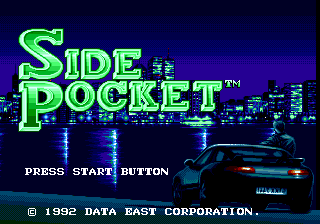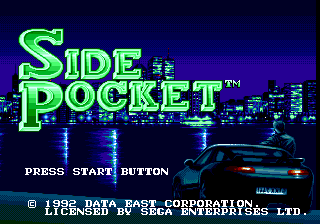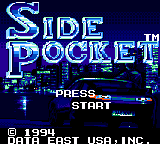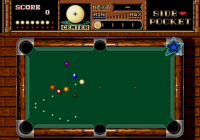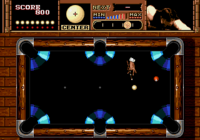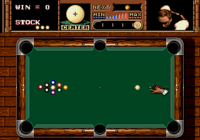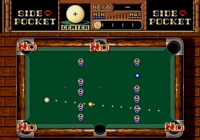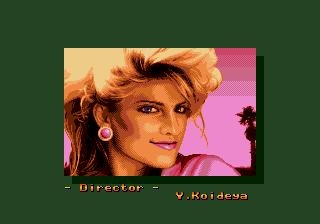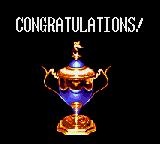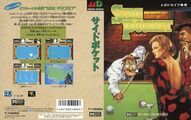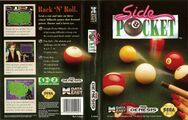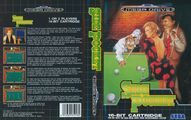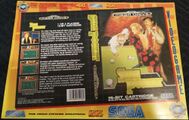Side Pocket
From Sega Retro
Side Pocket (サイドポケット) is a billiards game by Data East. Originally released as an arcade game in 1986, it was remade for the Sega Mega Drive in 1992 and the Sega Game Gear in 1994. The Game Gear version was only released in the United States.
Contents
Gameplay
The game is a pocket billiards simulation. The player uses a cue stick to strike the white cue ball, knocking the object balls (each having a different color and number) into any of the six pockets on a felt-covered table.
On each shot, the player can aim by rotating the D-Pad. The path indicator is displayed as a dotted line moving from the cue ball to its target. This line shows one bank if the cue ball hits one of the rails, to assist the player in making kick shots (shots where the cue ball is bounced off a rail before hitting an object ball).
To change the strike point where the cue stick hits the cue ball, the player holds ![]() and moves the D-Pad on the Mega Drive version or holds
and moves the D-Pad on the Mega Drive version or holds ![]() and moves the D-Pad on the Game Gear version. Changing the horizontal position allows the player to put "english" (spin) on the ball, which causes it to deflect in the opposite direction. The longer the distance that it travels, the greater the deflection. Changing the vertical position changes how the cue ball behaves after hitting an object ball. Hitting it low causes it to draw (bounce back toward its starting point), while hitting it high causes it to follow (continue its trajectory). Hitting it in the center causes it to stop dead after striking an object ball. Continuing to press
and moves the D-Pad on the Game Gear version. Changing the horizontal position allows the player to put "english" (spin) on the ball, which causes it to deflect in the opposite direction. The longer the distance that it travels, the greater the deflection. Changing the vertical position changes how the cue ball behaves after hitting an object ball. Hitting it low causes it to draw (bounce back toward its starting point), while hitting it high causes it to follow (continue its trajectory). Hitting it in the center causes it to stop dead after striking an object ball. Continuing to press ![]() past "Follow" offers "Massé" options where the cue stick is angled; hitting to the left or right here causes the cue ball to curve in that direction, while hitting toward the top causes the cue ball to jump.
past "Follow" offers "Massé" options where the cue stick is angled; hitting to the left or right here causes the cue ball to curve in that direction, while hitting toward the top causes the cue ball to jump.
To start the shot, the player presses ![]() on the Mega Drive version or
on the Mega Drive version or ![]() on the Game Gear version. This starts the power meter, which increases and decreases like the swing meter in a golf game. The player can take the shot by again pressing
on the Game Gear version. This starts the power meter, which increases and decreases like the swing meter in a golf game. The player can take the shot by again pressing ![]() on the Mega Drive version or
on the Mega Drive version or ![]() on the Game Gear version, which hits the ball with more force when the meter is higher (filled to the right). Or the player can cancel the shot (to change the aim or the strike point) by pressing
on the Game Gear version, which hits the ball with more force when the meter is higher (filled to the right). Or the player can cancel the shot (to change the aim or the strike point) by pressing ![]() on the Mega Drive version or
on the Mega Drive version or ![]() on the Game Gear version.
on the Game Gear version.
The player can show the toggle the view between showing the colors of the balls and showing their numbers with ![]() on the Mega Drive version and
on the Mega Drive version and ![]() on the Game Gear version. On the Mega Drive version, the player can switch between two styles of path indicator (dots and circles) by pausing the game with START and pressing
on the Game Gear version. On the Mega Drive version, the player can switch between two styles of path indicator (dots and circles) by pausing the game with START and pressing ![]() .
.
Modes
The Mega Drive version has one single-player mode (Pocket) and two two-player modes (Pocket and 9-Ball). The Game Gear version has two single-player modes (Pocket and 9-Ball) and one two-player mode (9-Ball). Both versions have the Trick mode.
In two-player games, the two players play a "lag" on the first rack (game) of a set to determine who goes first. Both competitors hit the cue ball to the foot cushion so that it bounces back to the head cushion; whichever player gets the ball to return closest to the head cushion wins the lag and gets to break. The power meter is the same for both players during the lag shot and starts automatically. After the first rack, the player who won the previous rack gets to break.
This is a straight pool game. In the Mega Drive version, this game can be played by one or two players. In the Game Gear version, this game is for one player only.
On either platform, the single-player game is played with a limited number of shots. There are five stages, and the player must attain a certain score in order to advance to the next class:
| Stage | Mega Drive | Game Gear | Requirements to advance | ||
|---|---|---|---|---|---|
| Name | Balls in rack | Name | Balls in rack | ||
| 1 | Los Angeles | 6 | Club Class | 6 | 3,000 points |
| 2 | Las Vegas | 9 | City Class | 9 | 4,000 points, plus a challenge shot |
| 3 | San Francisco | 6 | State Class | 6 | 5,000 points, plus a challenge shot |
| 4 | New York | 6 | Nation Class | 10 | 6,000 points, plus a challenge shot |
| 5 | Atlantic City | 10 | World Class | 6 | 7,000 points, plus a challenge shot (Mega Drive-only) |
Sinking a single ball is worth 100 points. If the player sinks multiple balls on a single shot, the first ball is worth 100 points, then each successive ball is worth 500 points. The player additionally receives 500 points for every successive ball sunk in consecutive order. The game shows the next numbered ball on the table in the box labeled "Next" at the top of the screen.
Most stages have an additional requirement of completing a challenge shot after clearing the table with enough points. This is a trick shot where the player has one chance to sink all of the balls on the table in a single shot and in one of the open pockets. Closed pockets are indicated by the word "No" appearing over them.
In the Mega Drive version, the player starts the game with 8 shots and loses a shot for missing (failing to pocket a ball on a turn) or fouling (pocketing the cue ball). In the Game Gear version, the player starts the game with 5 shots and loses half a shot for missing and a full shot for fouling. The cue ball is always returned to the head spot after scratching. Extra shots are earned after successfully completing a stage. If the player fails to get enough points to advance to the next stage, the stage is played again from a fresh break as long as the player still has shots remaining. Otherwise, the game ends if the player runs out of shots.
Occasionally, a flashing star appears over one of the pockets. Sinking a ball into this pocket before the star disappears awards extra points, extra shots, or an extra trick shot at the end of the stage for bonus points. Sometimes the word "Super" appears and one of the balls starts to flash. If this ball is hit before hitting any others, the cue ball moves around much more quickly and for longer.
When a single ball is left on the table, the word "Zone" appears over one of the pockets. Sinking a ball into this pocket awards extra points, extra shots, or an extra trick shot in the Mega Drive version or 1-5 extra shots in the Game Gear version. Sinking the cue ball causes all of the pockets to glow and awards a bonus after sinking the last ball, but this sacrifices a shot.
In the two-player version of the game, both players have unlimited shots and take turns shooting. The rack lasts until the table is cleared. Rather than progressing through five stages, the game is played to the best of 5 racks.
9-Ball
In the Mega Drive version, this game is exclusively for two players to the best of 3, 7, or 15 racks. In the Game Gear version, this game can be played by one player or by two players (over a Gear-to-Gear Cable) to the best of 1, 3, or 5 racks.
The game is played with a rack of nine balls. To win, a player must sink the 9-ball (the striped yellow ball). However, there is a rule that the player must hit the lowest-numbered ball on the table with the cue ball before hitting any other ball. Any ball can be sunk in any pocket on each turn (including the break) so long as the lower-numbered ball is hit by the cue ball first. The game shows the lowest-numbered ball on the table in the box labeled "Next" at the top of the screen.
If the player legally pockets a ball (after hitting the lower-numbered ball first), the player's inning continues. Failing to hit the lowest-numbered ball first (or failing to hit any ball with the cue ball) or pocketing the cue ball are fouls. When a player fouls, the other player's inning starts and that player has ball in hand (and can thus place the cue ball anywhere on the table). Any balls sunk illegally are spotted (returned to the table). Committing three fouls in a row loses the rack. Hitting the lower-numbered ball but failing to pocket any ball is not a foul but nonetheless ends the player's inning (without giving the other player ball in hand).
On the Game Gear, the one-player version of the game follows the same rules, except there is no lag shot and the player's inning never ends (until the game is won or lost). This version can be played by two or more players on a single console if the players alternate turns whenever a player misses or fouls.
Trick
This is a puzzle mode that has the player performing trick shots in prearranged scenarios. The player has only one shot to sink all of the balls on the table into any of the open pockets. Some of the pockets are marked "No" to indicate that they are blocked. Many of the scenarios have glasses on the table that the player must shoot around; touching a glass breaks it and fails the scenario. There are 19 scenarios in all (which are different between the Mega Drive and Game Gear versions of the game).
On the Mega Drive version, each scenario completed reveals a piece of a portrait of a woman. After completing every scenario, the player can solve a sliding puzzle to arrange the pieces into the correct picture.
Versions
Despite sharing a name (and as a billiards game, similar gameplay) to their 1986 arcade counterpart, the home versions of Side Pocket differ considerably to their older sibling, with entirely different graphics and sound, and more modes of play.
The Mega Drive and Super NES versions of the game are for the most part identical, though as was common for the era, the Mega Drive offers a larger screen resolution in exchange for fewer on-screen colours. On the Game Gear, most of the features are retained, however the smaller screen of the handheld leads to a smaller table, which in turn can potentially simplify the physics. The Game Gear and Game Boy versions, unlike the other home versions, both support single-player 9-ball games.
History
Legacy
Side Pocket was followed on the Mega Drive by Minnesota Fats: Pool Legend in 1995. A Minnesota Fats game was also released that same year for the Sega Saturn, known as Side Pocket 2: Densetsu no Hustler in Japan.
An update, Side Pocket: Special Edition, was planned for the Sega Mega-CD but did not materialise.
Production credits
Mega Drive version
- Director: Y.Koideya
- Planner: Daore.Tsuzawa
- Programmers: TALA., Fuji.
- Sound: Koremasa., Emi.Shimizu
- Graphics: Pochi., MAO., Megupi.
- Presented by: DATA EAST
Game Gear version
- Director: T.Kajiwara
- Programmer: Kim, H.Fujiwara
- Graphic Designer: Y.Mizutani, N.Ishigami
- Sound Designer: Ymoh.S
- Supervisor: S.Saka
- Producer: H.Fukuda, Y.Kawai, M.Noguchi, Y.Nakamura
- Special Thanks: H.Nakamoto, T.Idogawa, Y.Sawai, S.Miki, H.Iwano
- Executive Producer: Tetsuo Fukuda
- Presented by: Data East
Digital manuals
Magazine articles
- Main article: Side Pocket/Magazine articles.
Promotional material
Physical scans
Mega Drive version
| Sega Retro Average | ||||||||||||||||||||||||||||||||||||||||||||||||||||||||||||||||||||||||||||||||||||||||||||||||||||||||||||||||||||||||||||||||||||||||||||||||||||||||||||||||||||||||||||||||||||||||||||||||||||||||||||
|---|---|---|---|---|---|---|---|---|---|---|---|---|---|---|---|---|---|---|---|---|---|---|---|---|---|---|---|---|---|---|---|---|---|---|---|---|---|---|---|---|---|---|---|---|---|---|---|---|---|---|---|---|---|---|---|---|---|---|---|---|---|---|---|---|---|---|---|---|---|---|---|---|---|---|---|---|---|---|---|---|---|---|---|---|---|---|---|---|---|---|---|---|---|---|---|---|---|---|---|---|---|---|---|---|---|---|---|---|---|---|---|---|---|---|---|---|---|---|---|---|---|---|---|---|---|---|---|---|---|---|---|---|---|---|---|---|---|---|---|---|---|---|---|---|---|---|---|---|---|---|---|---|---|---|---|---|---|---|---|---|---|---|---|---|---|---|---|---|---|---|---|---|---|---|---|---|---|---|---|---|---|---|---|---|---|---|---|---|---|---|---|---|---|---|---|---|---|---|---|---|---|---|---|---|
|
| 71 | |
|---|---|
| Based on 40 reviews | |
| Mega Drive, SE (rental; Hent; orange) |
|---|
| Mega Drive, AU |
|---|
|
Game Gear version
| Sega Retro Average | |||||||||||||||||||||||||||||
|---|---|---|---|---|---|---|---|---|---|---|---|---|---|---|---|---|---|---|---|---|---|---|---|---|---|---|---|---|---|
|
| 69 | |
|---|---|
| Based on 5 reviews | |
Technical information
- Main article: Side Pocket/Technical information.
References
- ↑ File:SidePocket MD JP Box.jpg
- ↑ 2.0 2.1 https://sega.jp/history/hard/megadrive/software_l.html (Wayback Machine: 2020-07-02 23:21)
- ↑ GamePro, "May 1992" (US; 1992-xx-xx), page 84
- ↑ 4.0 4.1 GamePro, "November 1992" (US; 1992-xx-xx), page 58
- ↑ 5.0 5.1 VideoGames & Computer Entertainment, "September 1992" (US; 1992-0x-xx), page 52
- ↑ Sega Channel schedule (US; 1994-06-01)
- ↑ GamesMaster, "March 1993" (UK; 1993-02-18), page 16
- ↑ Sega Pro, "May 1993" (UK; 1993-04-08), page 18
- ↑ 9.0 9.1 Computer & Video Games, "November 1992" (UK; 1992-10-15), page 84
- ↑ 10.0 10.1 Game Players, "Vol. 7 No. 7 July 1994" (US; 1994-0x-xx), page 56
- ↑ https://www.amusement-center.com/project/egg/game/?product_id=870
- ↑ File:Side Pocket MD credits.pdf
- ↑ File:Side Pocket GG credits.pdf
- ↑ Electronic Gaming Monthly, "October 1992" (US; 1992-xx-xx), page 91
- ↑ Electronic Gaming Monthly, "December 1992" (US; 1992-xx-xx), page 129
- ↑ 1700 igr dlya Sega, "" (RU; 2001-xx-xx), page 208
- ↑ Aktueller Software Markt, "Dezember 1992" (DE; 1992-11-13), page 144
- ↑ Beep! MegaDrive, "August 1992" (JP; 1992-07-08), page 29
- ↑ Consoles +, "Novembre 1992" (FR; 1992-1x-xx), page 98
- ↑ Cool Gamer, "9" (RU; 2002-10-13), page 187
- ↑ Digitiser (UK) (1993-04-22)
- ↑ Electronic Games (1992-1995), "October 1992" (US; 1992-xx-xx), page 70
- ↑ Electronic Gaming Monthly, "July 1992" (US; 1992-xx-xx), page 24
- ↑ Mean Machines: The Essential Sega Guide, "" (UK; 1993-11-18), page 89
- ↑ Game Power, "Ottobre 1993" (IT; 1993-xx-xx), page 103
- ↑ Hippon Super, "August 1992" (JP; 1992-07-04), page 37
- ↑ Joypad, "Octobre 1992" (FR; 1992-10-xx), page 74
- ↑ Joystick, "Novembre 1992" (FR; 1992-1x-xx), page 153
- ↑ Sega Mega Drive Advanced Gaming, "November 1992" (UK; 1992-xx-xx), page 30
- ↑ Sega Mega Drive Advanced Gaming, "January 1993" (UK; 199x-xx-xx), page 94
- ↑ Mega Drive Fan, "February 1993" (JP; 1993-01-xx), page 59
- ↑ Mega, "November 1992" (UK; 1992-10-15), page 60
- ↑ Mega Action, "June 1993" (UK; 1993-05-20), page 64
- ↑ Mega Fun, "09/92" (DE; 1992-09-22), page 38
- ↑ Mega Play, "August 1992" (US; 1992-0x-xx), page 64
- ↑ MegaTech, "November 1992" (UK; 1992-10-20), page 40
- ↑ Marukatsu Mega Drive, "September 1992" (JP; 1992-08-xx), page 120
- ↑ Player One, "Mai/Juin 1993" (FR; 1993-05-10), page 78
- ↑ Play Time, "12/92" (DE; 1992-11-04), page 93
- ↑ Power Up!, "Saturday, April 10, 1993" (UK; 1993-04-10), page 1
- ↑ Power Play, "3/93" (DE; 1993-02-10), page 109
- ↑ Sega Power, "December 1992" (UK; 1992-11-05), page 52
- ↑ Sega Pro, "November 1992" (UK; 1992-10-08), page 40
- ↑ Sega Pro, "April 1993" (UK; 1993-03-11), page 67
- ↑ Sega Zone, "December 1992" (UK; 1992-11-xx), page 28
- ↑ Sega Force, "2/93" (SE; 1993-03-18), page 11
- ↑ Sega Force, "November 1992" (UK; 1992-10-08), page 72
- ↑ Sega Mega Drive Review, "1" (RU; 1995-04-03), page 137
- ↑ Sega Opisaniy i sekretov, "14000 Opisaniy i sekretov" (RU; 2003-03-11), page 163
- ↑ Sega Saturn Magazine, "September 1995" (JP; 1995-08-08), page 85
- ↑ Supergame, "Novembro 1992" (BR; 1992-11-xx), page 23
- ↑ Video Games, "3/93" (DE; 1993-02-24), page 89
- ↑ Electronic Games (1992-1995), "August 1994" (US; 1994-0x-xx), page 84
- ↑ Electronic Gaming Monthly, "June 1994" (US; 1994-xx-xx), page 40
- ↑ GamePro, "July 1994" (US; 1994-xx-xx), page 136
- ↑ VideoGames, "August 1994" (US; 1994-0x-xx), page 76
| Side Pocket | |
|---|---|
|
Main page | Comparisons | Maps | Hidden content | Magazine articles | Video coverage | Reception | Promotional material | Region coding | Technical information | Bootlegs | |
| Side Pocket games for Sega systems | |
|---|---|
| Side Pocket (1992) | Minnesota Fats: Pool Legend (1995) | |
| Side Pocket: Special Edition (unreleased) | |
| Side Pocket (1994) | |
| Minnesota Fats: Pool Legend (1995) | Side Pocket 3 (1997) | |
- Gear-to-Gear Cable-compatible games
- 1-2 player games
- JP Mega Drive games
- All JP games
- US Mega Drive games
- All US games
- US Sega Channel games
- EU Mega Drive games
- All EU games
- PT Mega Drive games
- All PT games
- UK Mega Drive games
- All UK games
- SE Mega Drive games
- All SE games
- AU Mega Drive games
- All AU games
- AS Mega Drive games
- All AS games
- Mega Drive games
- 1992 Mega Drive games
- All 1992 games
- Mega Drive billiards games
- Mega Drive table games
- All table games
- US Game Gear games
- Game Gear games
- 1994 Game Gear games
- All 1994 games
- Game Gear billiards games
- Game Gear table games
- Project EGG games
- All games
- Side Pocket
- Side Pocket (franchise)
